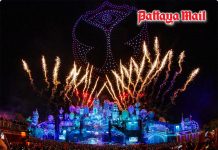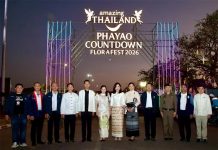Nan’s geographical location, midway between Chiang Mai and Luang Prabang, means that the town absorbed the cultures of both regions over several hundred years.
Last year, Nan became the town that many Thais wanted to visit thanks to a romantic novel by one of Thailand’s leading bankers, Banthoon Lamsam. His first novel Sinehamonta Haeng Lanna was inspired by Nan’s ancient legend of the Lanna kingdom – indeed the title translates as The Seductive Spell of Lanna. The banker fell in love with Nan and even took over one of the town’s old wooden guesthouses, transforming it into the now-trendy Pukha Nanfa boutique hotel.
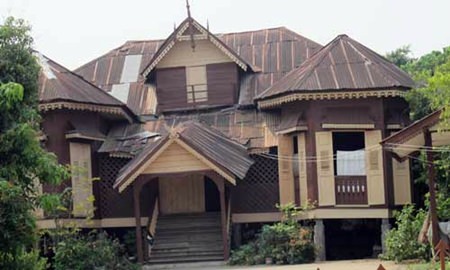 Distinguished old wooden house en route the tram tour
Distinguished old wooden house en route the tram tour
The atmosphere that inspired Banthoon to write his novel has attracted other writers and artists to Nan. A local TAT official told me that, “In recent years, travel writers have come here to write about the town, and many artists have set up movements here, too. Banthoon’s book of course has been a catalyst. Since his novel came out, many people have put Nan on their “must-see” lists and tourist numbers have risen accordingly.”
Cultural attractions
Many visitors arrive in Nan by plane and start their tours of the town in the city centre. But if you would like to follow in the royal footsteps of Their Majesties the King and Queen when they first visited Nan province back in 1958, then travel by road from Phrae as they did.
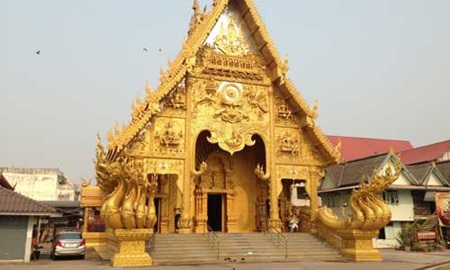 Glittering golden decoration at Wat Sri Phan Ton.
Glittering golden decoration at Wat Sri Phan Ton.
We did too. From Phrae province, it took us about a one and a half hour drive to Wiang Sa, a small but peaceful district. The local people here are proud that they were the ones to welcome Their Majesties the King and Queen to the area almost 60 years ago.
The old Wiang Sa District Office, where the royal couple stayed, has now been turned into a museum exhibiting historical photos and objects of those memorable event as well as displaying traditional household items and artefacts of the district. The museum is open every day.
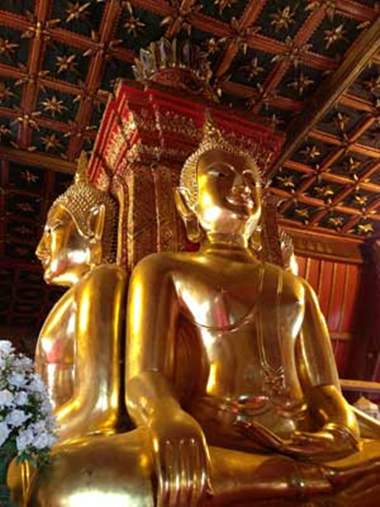 Buddha image facing four directions at Wat Phumin.
Buddha image facing four directions at Wat Phumin.
Not far from the Wiang Sa Museum is another private museum Huern Chakkayan (House of Bicycles) where a large collections of historic bicycles are exhibited. Opened in 2007, the collection belongs to Mr. Supot Tengtrairat whose passion for the two-wheeled transportation inspired him to collect more than 150 historic examples, including one of the oldest bikes on offer that dates back to 1880 and came all the way from Germany. The Museum is open from 09:00 – 11:00 and 12:00-14:00 hrs. Admission is free, but you do need to notify the owners in advance if you want to look round. (Tel: +66 (0) 5478 1359). There is a nice little café where you can enjoy fine quality coffee among the bikes.
Some 20 minutes’ drive from Wiang Sa is Ho Silp Rim Nan (Nan Riverside Art Gallery) by the famous Thai artist and Nan native, Mr. Wichai Prabliboo. The gallery features his paintings and sculptures as well as the work of other Nan artists. Mr. Wichai told me that he was most proud of his picture of Her Royal Highness Princess Sirindhorn which is titled as ‘Takone’ (shout). “The Princess wanted to evoke the famous mural painting ‘Krasip’ (whisper) at Wat Phumin. It shows what a great sense of humour she has,’’ he said.
Within the art gallery is a photo exhibit of Nan’s famous mural paintings by the artist known as “Nan Buapan.” Research into the style of these unique paintings at Wat Phumin and Wat Nongbuahas shows they have been done by the same hand. There also seems to be a Western influence in the works which depict scenes of everyday life. Some experts even think that one of the famous murals evokes Auguste Rodin’s famous “The Thinker” sculpture. It is well worth visiting the temples to see the originals and to judge for yourself if you think they have a hint of Western influence. The gallery opens every day from 09:00-17:00 hrs. except Wednesday Tel: +66 (0) 81 989 2912
Nan’s Old Quarter
With a history that goes back to the 14th century, when the northern kingdom of Lanna was at its peak, you can expect that there is a lot to see in Nan. Many of the town’s historic attractions have been preserved or restored. A walk around the town can feel like a trip back in time.
One of the best ways to see the attractions is to take a tour on the city’s tram. Tickets cost 30 Baht per person and can be bought at the Tourist Information Centre opposite the famous Wat Phumin. The guided tour travels around the older areas of the town and takes in 15 temples as well as the town’s old wooden houses.
The tram trip takes a 10-minute break at Wat Suan Tan where local guides give tours of the picturesque temple in both English and Thai. Another tram stop takes in the local Ban Phra Kert community museum, which exhibits valuable ancient artefacts; such as, Lanna-style wooden Buddha images and some of the everyday household items used in this historic district.
Tours take place twice daily at 10:30 and 15:30 hrs. at weekends and on public holidays and once a day at 15:30 hrs. on weekdays. If you are taking a group to Nan, it is possible to hire a whole tram for 28 people for 500 Baht.
If time allows, do make sure you visit Wat Phumin in the centre of the old quarter. This famous temple is known for its unique cruciform Ubosoth and its ancient murals painted by the Thai Lue artist group. In the temple’s centre is a glittering quartet of golden Buddha images facing North, South, East and West.
I took time to visit other temples in Nan’s old town and went to enjoy the exquisitely sculptured golden Nagas at Wat Si Phan Ton. If you visit, do look out for the lovely sculptures that decorate the entrance of Ubosot building. I then stopped by the City Pillar which is revered by the local people of the town. This can be found in the compound of Wat Ming Mueang where the religious buildings and temples, are all rendered in white, which is unique in Thailand.
At Wat Phra That Khao Noi, you will be mesmerised by a panoramic view over the whole town of Nan and the hills beyond. There is also a beautiful standing Buddha here who seems to stand guard over the whole vast valley.
Nan is a heaven for history buffs and there is something to see around every corner. Culture vultures are coming from around the world. In fact, one guide we met on our tram tour is a young German girl, here on a two-month volunteer scheme. She told me how she loved chatting to tourists, Thai and international alike, about the town. She is just one of the people who have fallen under the enchanting spell of Nan, which has captured the hearts of everyone from bankers to artists, and writers to students. I for one have certainly fallen in love with the place and I know that I will be back soon.
For high-resolution images, please click to visit the TAT Newsroom Photo Library: Destination Nan, northern Thailand.



